



August 31, 2016
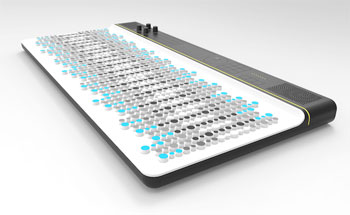
I'm glad to see that Keaton Van't Hull's drawings of imagined Tonal Plexus keyboard designs created a stir. There is more to say about his work, but before I do that I want to continue telling how the Tonal Plexus came about. If you've missed previous entries about this, you can find them by scrolling down. I had left off with this previous entry. The thread will continue for a while because there is a lot I'd like to tell you, and we'll make our way back to the drawings in due time.
The story continues at the turn of the 21st century. After a frigid time in Minneapolis, with the help of some very generous friends I made my way to reasonably warmer climes at the north edge of a much bigger city — Chicago. There must be some way to give you a sense of the heady pace of rapid progress I was able to make there between 2000 to 2002, but I'm not sure what it is. I was working for Borders Books (which famously went bankrupt and closed all its doors in 2011, but back in 2000 it was thriving). For someone like me, Borders was a fantastic place to work. I was the "classical music specialist". A lot of smart and interesting people worked at Borders in Willmette, and I became friends with several of them. Often as a direct result of their help and encouragement, I made huge strides with my research.
I must thank my dear colleague Katarzyna Grochowska for making my library research possible during that time. Kasia was then a doctoral student at the University of Chicago in musicology, working at Borders part time, and she saw that I needed library access. Through her University library account, I was able to check out all the books I needed to continue my research. These were not just music books; they were source volumes on research in sensation and perception, color theory, measurement science, and so on. Without library access, I would not have been able to formulate the right questions, and would not have arrived at the right answers.
In Chicago, important discoveries seemed to take place almost on a daily basis. I'll focus on a few of the important steps that took place.
A few posts ago, I shared an experimental piece of music in Just Intonation made on the Commodore 64. As fun as it was to use that machine again to explore the vast new territory of JI, by the time I was in Chicago, I knew that I had to get back into computer programming using current machines like the Mac. There was really no choice; the ideas demanded it. The Commodore 64 was still a great tool, but was incompatible with anything current, too limited. For example, the rhythmic pace of Jacob's Ladder was not something over which I had much control. It was determined by the speed at which the Commodore could process the data I was feeding it to produce the desired output.
Apart from experiments with the Commodore and some twelve-tone music programs I had written for my friend Luke Palmer in graduate school in Cincinnati in the late 90's (on PC Windows boxes running QBasic), I hadn't been programming computers since the 1980's. An awful lot had changed in the interim — most importantly what I learned later was the paradigm shift from "spaghetti coding" to "object oriented coding". There was a lot to learn. The books Brian had given me seemed pretty strange and unlike what I understood as computer programming. HTML looked like some kind of outlining tool. I understood the logic structures of Javascript, but I couldn't see how learning Javascript would help me write software. All the new computers had no programming interface as far as I could tell. To me they seemed like magic boxes, not programming tools. How do you write a program by clicking a mouse? I had no idea. I struggled to comprehend what it even was that I needed to learn.

Feeling out of the loop and frustrated by things I couldn't understand, I sent out some fairly desperate emails asking for guidance in modern computer programming to people I barely knew, like Carla Scaletti at Symbolic Sound. That didn't work. (A colleague and friend from EIU, Tucker Robison, who had earned a doctorate in composition from the U of I and had studied with Ben Johnston, had taken me to see the Symbolic Sound lab at the U of I in 1999, and I met Carla and Kurt Hebel there.) Then an opportunity arose through a co-worker at Borders to barter for a copy of the visual programming software called MAX. I don't remember which version was current at that time, but as you might guess, the MAX of 2000 was less powerful than the MAX of 2016. I read the language reference (it was very long), and learned how to use it on my Mac Powerbook 3400 running OS9. Using MAX required a different way of working than I had been used to with BASIC on the Commodore, and initially I felt annoyed by the visual orientation, but with MAX, I was finally able to make the computer do things.
The learning curve seemed steep, but it wasn't long before I was building full-blown programs implementing Just Intonation. Ironically, working with newer technology was not as easy as it had been on the Commodore 64. The new challenge was MIDI, which was not at all made for Just Intonation. Instead of working directly with frequencies and producing output, the frequencies had to be turned into MIDI data. At that time MAX didn't have MSP, and it also didn't provide a way to convert between frequencies and MIDI data, but of course it was possible to do it on my own using a combination MIDI Note and Pitch Bend messages, so that's what I did.
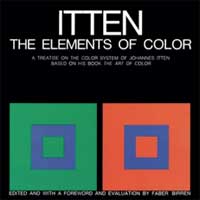
At that time, the idea of a keyboard capable of playing in Just Intonation was a distant goal. I considered it beyond what I understood how to do at the time. Instead, I focused on the idea of a monophonic instrument for Just Intonation, and through many discussions with my friend Luke, arrived at the idea for a wind controller.
This was first instrument I designed: a monophonic wind controller called The Goose. This instrument is capable of over 38,000 pitches per octave. The concept upon which it is based had its roots somewhere in 1996 during my last year at the College Conservatory of Music in Cincinnati, when I was briefly a student of Allen Sapp, who gave me a copy of a book called ITTEN: The Elements of Color.
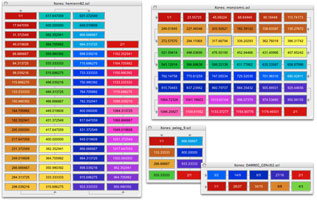
The theory behind the Goose has been online for some years as part of the H-System, specifically, the page called H-Chroma, which is the name I gave to a system originally called Trichromitic Number Theory. In a nutshell, this is a way of looking at numbers, such that any number can be represented as a specific mixture of 2 out of 3 primary colors. The idea behind this is fairly simple.
Just Intonation is a way of looking at pitches and intervals which relies on numbers — a lot of numbers. Anyone who wants to understand Just Intonation has to get into those numbers and understand what they mean. For me this was not a problem, even though, despite my abilities with computers, I honestly had a rather poor background in mathematics. The first obvious problem with JI is that it doesn't correspond to music notation. It's a system of numbers, not a system of lines and dots. The notation problem was my first concern. Secondly, I know too many musicians who don't like numbers. The requirement of number facility is a huge barrier to Just Intonation ever becoming mainstream. So, I set about to figure out some way to make JI (1) able to be notated and (2) able to be understood without numbers. The answer was to use colors. Not a new idea, it turns out. But what I discovered was in fact new, and it's a very important discovery that has of yet received basically no attention whatsoever. You can see this discovery implemented in my ear training software Xentone. It's a theory that turns numbers into colors, so that nobody really needs to know what the numbers are, they only need to be able to identify the colors. Of course, there is the problem of color blindness. There are also problems involved with of color perception and identification. Problems with color reproduction, printing. I did all the research, believe me, and I optimized everything according to those problems. To anyone familiar with the history of colors in music notation and music theory, let me say very clearly at this point, the system I propose has not been proposed by anyone else in history. I mention some other music-color systems on the H-Chroma page, which gives a basic summary of the system.
Let me try to give a super-short summary here. Trichromatic number theory provides a way to represent any number with a color, and it works like this: every even number reduces through binary division to an odd number, and every odd number greater than 5 is considered a sum of two numbers in a counting sequence. The primes 2, 3, and 5 are red, blue, and yellow, respectively.
The correspondence is not arbitrary; see the H-Chroma page for more information. Here is a chart showing how the system works with 23-limit Just Intonation.
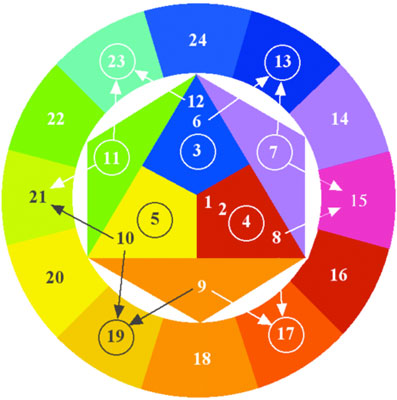
… and 47-limit Just Intonation.
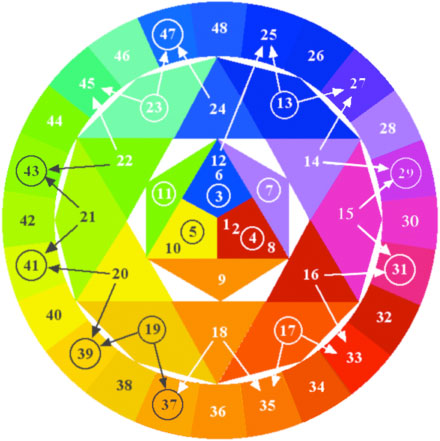
Let me back up a bit and explain that when I was in Minnesota, I was working on this idea, not from the angle of an instrument design, but from the angle of music notation. I was trying to come up with a notation system for music in Just Intonation, and using colors seemed logical. At that time I didn't know much about what other composers had done to notate music tuned in JI. The notation I came up with had lines that were spaced unequally and varied in thickness. I was also using the colors blue and red to indicate 3/2 and 4/3. Because harps sometimes have blue and red strings indicating fifth relations, I was calling this notation at the time "Harp notation". At U Minn, I was lucky to be able to enroll in a class focusing on the music of the Balkan region with Bosnian professor Mirjana Lausevic. Her final assignment was to analyze a piece of music from the Balkans, and I transcribed a short Bosnian folk song using the notation. I've since lost the paper, but it represents the first step towards what later became H-Chroma, and without it, I can assure you that the Tonal Plexus would not exist.
I will pick up the story here next time and say more about the Goose, which leads fairly swiftly to the first Tonal Plexus prototype. Until then …
Best Regards,
Aaron
[ Showing 1 entry | Next entry | Show all entries ]